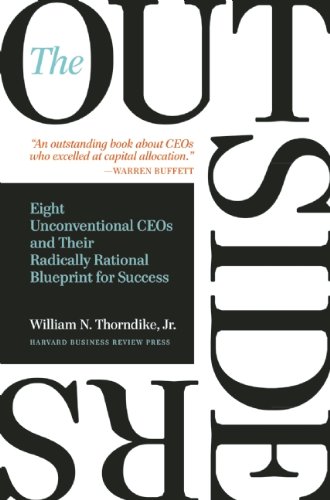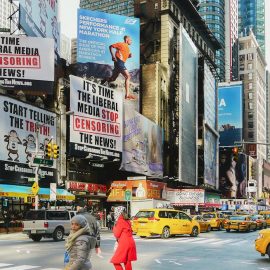

This article is an excerpt from the Shortform summary of "The Outsiders" by William N. Thorndike, Jr. Shortform has the world's best summaries of books you should be reading.
Like this article? Sign up for a free trial here .
Why did General Cinema cease to operate after building a successful and diverse company? How can diversifying your portfolio create more value?
Even though General Cinema ceased operations in 2006, it is still regarded as one of the most successful companies of the twentieth century. Find out how General Cinema’s CEO Dick Smith increased company value, and then created profit for investors.
General Cinema: Beyond Movie Theaters
General Cinema was a movie theater company founded in 1922 by Phillip Smith, who expanded drive-in theaters throughout New England and the Midwest. When he died in 1962, his son Dick Smith took over as CEO. Dick further expanded the company’s theater locations, then diversified into unrelated businesses such as beverage bottling and retail. While diversifying acquisitions often end in failure, Smith executed them with finesse, leading to fantastic performance when the company’s divisions were sold at premium prices in the 2000s.
General Cinema History
In 1962, when Dick Smith was 37 years old, he took over as CEO of General Cinema. He had been working in the family business after graduating from college and World War II.
Movie theaters had strong economics:
- It had negative working capital, since moviegoers paid instantly but movie studios were paid on 90 day terms.
- It had low capital requirements—a theater took little to maintain once it was built.
Smith’s first move was to expand the company’s theater footprint. He innovated in three ways:
- He expanded into suburban shopping malls, realizing that demographic trends were pointing to population growth in these areas.
- He expanded quickly by leasing land to develop theaters on, instead of purchasing the land under it. He realized that the theaters’ strong, predictable cash flow would make this financially viable, and it reduced the upfront investment needed for new locations.
- He increased the number of screens per theater to increase audiences and concession sales.
Diversification into Beverages
By the late 1960s, he figured that theater growth would likely plateau at some point, so he began looking to diversify into other businesses. His ultimate goal was to have three legs in the company, each a strong business that wasn’t correlated with the others.
In 1968, he entered beverage bottling by purchasing American Beverage Company (ABC), the largest independent Pepsi bottler, for 20% of his company’s enterprise value. His work in theater concessions had given him an appreciation for the attractive market dynamics of beverage bottling:
- Beverage companies formed an oligopoly, representing high returns on capital and strong long-term prospects.
- Pepsi bottlers tended to be fragmented, compared to the larger Coca-Cola bottlers. Furthermore, since they served the #2 brand (Pepsi), they tended to have lower valuations. Thus, Smith could buy up bottlers for lower prices.
- ABC could serve as a platform company, to which new acquisitions of bottlers would be added to increase scale and profits.
Over the next decade, Smith purchased more bottling companies. Increasing scale allowed for ever more efficient operations, such as negotiating down can prices and buying its own sugar instead of having it supplied by Pepsi.
The Third Leg—Retail
With this business established, Smith searched for his third leg. He explored broadcast media, though the prices were so high he never made a meaningful entry. He engaged in making minority investments in public companies.
His opportunity came in 1985, when he was called in to help retail conglomerate Carter Hawley Hale (CHH) avoid a hostile takeover. CHH owned properties such as department stores Broadway and Neiman Marcus. CHH desperately needed an investor to buy a substantial portion of shares to defeat the takeover, and they needed a response within a literal few days.
Smith realized that the seller’s urgency and tight timetable meant that very few buyers would participate, and so he could have immense negotiating leverage. Over the weekend, he and his team scrutinized the deal, prepared financing, and closed the deal by Thursday.
Flexing his leverage, Smith secured very favorable terms—a preferred security guaranteed them a 10% return, gave them an option to convert to 40% of common stock, and options to buy operating divisions of CHH. In essence, they borrowed money at 6% to earn 10%.
Later, General Cinema exchanged its 40% stock in CHH for 60% of the retail division that included Neiman Marcus. Smith saw that Neiman Marcus was poorly managed by its owner, and growth of stores would allow a premium on exit.
Altogether, this investment in CHH would ultimately return at a rate of 51.2%—good work for a weekend.
Sale and a New Third Leg
In the late 1980s, the Pepsi beverage industry soured due to aggression from Coke and increased competition for buying beverage franchises. He sold the bottling business to Pepsi and started looking for another third leg.
In 1990, the publisher Harcourt Brace Jovanovich (HBJ) piqued his attention. HBJ published in education and science. In 1986, it faced the threat of a hostile takeover, and so it took on a large amount of debt and paid a large dividend. HBJ avoided a takeover, but it now staggered under its debt. It began missing debt payments, and vulture investors circled, waiting for a kill. HBJ decided to go up for auction.
As with CHH, Smith knew that he had leverage in this acquisition. HBJ’s complicated debt required a complicated deal, which would scare off buyers. However, publishing had low capital requirements and few assets, thus improving its economics.
Over 18 months, Smith negotiated with its creditors and ultimately purchased the company for $1.56 billion, over 60% of General Cinema’s market capitalization. He got it at a discount of 6 times cash flow.
The End of General Cinema
Over the 1990s and 2000s, Smith gradually sold the operating businesses:
- In 1991, the theater business was spun off into GC Companies (which would ultimately go bankrupt in 2000 and be purchased by AMC).
- In 2003, HBJ was acquired by Reed Elsevier.
- In 2006, Neiman Marcus was acquired by a group of private equity firms. Smith saw that expanding Neiman Marcus would be expensive, while private equity firms were paying record amounts for retail.
With this, General Cinema ceased to operate, returning tremendous value for shareholders through 43 years of Dick Smith’s leadership.
General Cinema Performance
From 1962 to 2005, General Cinema (and its spinoffs) showed a 16.1% annual return rate, compared to 9% for the S&P 500 and 9.8% for GE.
$1 invested at the beginning would have been worth $684 by the end. This outperformed the S&P by 15.8 times, and GE by 11.4 times.
General Cinema may have ceased operating, but it was still one of the most successful companies of the twentieth century. General Cinema offers a valuable lesson that a company doesn’t have to exist forever and grow exponentially in order to be profitable. With a smart strategy and consistent profits, General Cinema proved its worth.

———End of Preview———
Like what you just read? Read the rest of the world's best summary of William N. Thorndike, Jr's "The Outsiders" at Shortform .
Here's what you'll find in our full The Outsiders summary :
- What great CEOs like Warren Buffett do that average CEOs don't
- How to master the art of capital allocation
- How to be a great manager that your team is excited to work with






